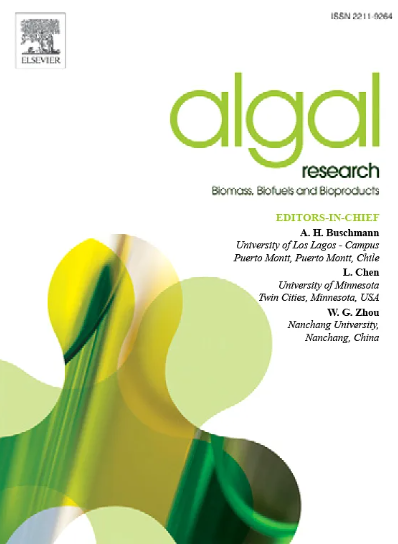Isolation of a novel polysaccharide from Tribonema minus and preparation of polysaccharide–selenium nanoparticles with enhanced antioxidant activity
IF 4.6
2区 生物学
Q1 BIOTECHNOLOGY & APPLIED MICROBIOLOGY
Algal Research-Biomass Biofuels and Bioproducts
Pub Date : 2025-03-28
DOI:10.1016/j.algal.2025.104020
引用次数: 0
Abstract
Tribonema polysaccharide (TP), a biologically active polysaccharide containing β-1,3-glycosidic bonds, has not been extensively studied as a dispersing agent for stabilising selenium nanoparticles (SeNPs), and its synergistic effects with SeNPs remain poorly understood. This study investigates the relationship between the antioxidant activity and physicochemical properties of TP–SeNPs, which were synthesised through chemical reduction at varying TP-to‑selenium mass ratios (TPSMRs). TP was isolated from Tribonema minus using ultrasonic-assisted extraction, achieving a 119.64 % increase in yield under optimal conditions (400 W, 25 min, 1:400 solid-to-liquid ratio). Structural analysis identified TP as a novel β-1,3-glucan (8.46 kDa) composed exclusively of glucose units. Moreover, TP–SeNPs prepared at varying TPSMRs exhibited significantly higher antioxidant activity than either TP or SeNPs alone, demonstrating a clear synergistic effect. Notably, TP–SeNPs prepared at a TPSMR of 2:3 exhibited the lowest half-maximal inhibitory concentrations for scavenging 2,2-diphenyl-1-picrylhydrazyl, superoxide anions, and hydroxyl radicals (0.30, 0.77 and 0.46 mg/mL, respectively). This was attributed to the increased selenium content and reduced particle size of these complexes. Additionally, TP–SeNPs displayed excellent dispersibility and stability, likely due to non-covalent interactions between TP and SeNPs. In cellular assays, TP–SeNPs exhibited low cytotoxicity and dose-dependently enhanced cell viability under H2O2-induced oxidative stress. Cells treated with 200 mg/L TP–SeNPs exhibited a 35.83 % increase in viability compared with the model group. This protection was associated with elevated antioxidant enzyme activity, increased glutathione levels and reduced malondialdehyde content, thereby mitigating oxidative damage in HepG2 cells. This study is the first to characterise a novel β-1,3-glucan from T. minus and to elucidate the structure–activity relationships of TP–SeNPs, highlighting their potential as functional additives or pharmaceutical supplements.

求助全文
约1分钟内获得全文
求助全文
来源期刊

Algal Research-Biomass Biofuels and Bioproducts
BIOTECHNOLOGY & APPLIED MICROBIOLOGY-
CiteScore
9.40
自引率
7.80%
发文量
332
期刊介绍:
Algal Research is an international phycology journal covering all areas of emerging technologies in algae biology, biomass production, cultivation, harvesting, extraction, bioproducts, biorefinery, engineering, and econometrics. Algae is defined to include cyanobacteria, microalgae, and protists and symbionts of interest in biotechnology. The journal publishes original research and reviews for the following scope: algal biology, including but not exclusive to: phylogeny, biodiversity, molecular traits, metabolic regulation, and genetic engineering, algal cultivation, e.g. phototrophic systems, heterotrophic systems, and mixotrophic systems, algal harvesting and extraction systems, biotechnology to convert algal biomass and components into biofuels and bioproducts, e.g., nutraceuticals, pharmaceuticals, animal feed, plastics, etc. algal products and their economic assessment
 求助内容:
求助内容: 应助结果提醒方式:
应助结果提醒方式:


